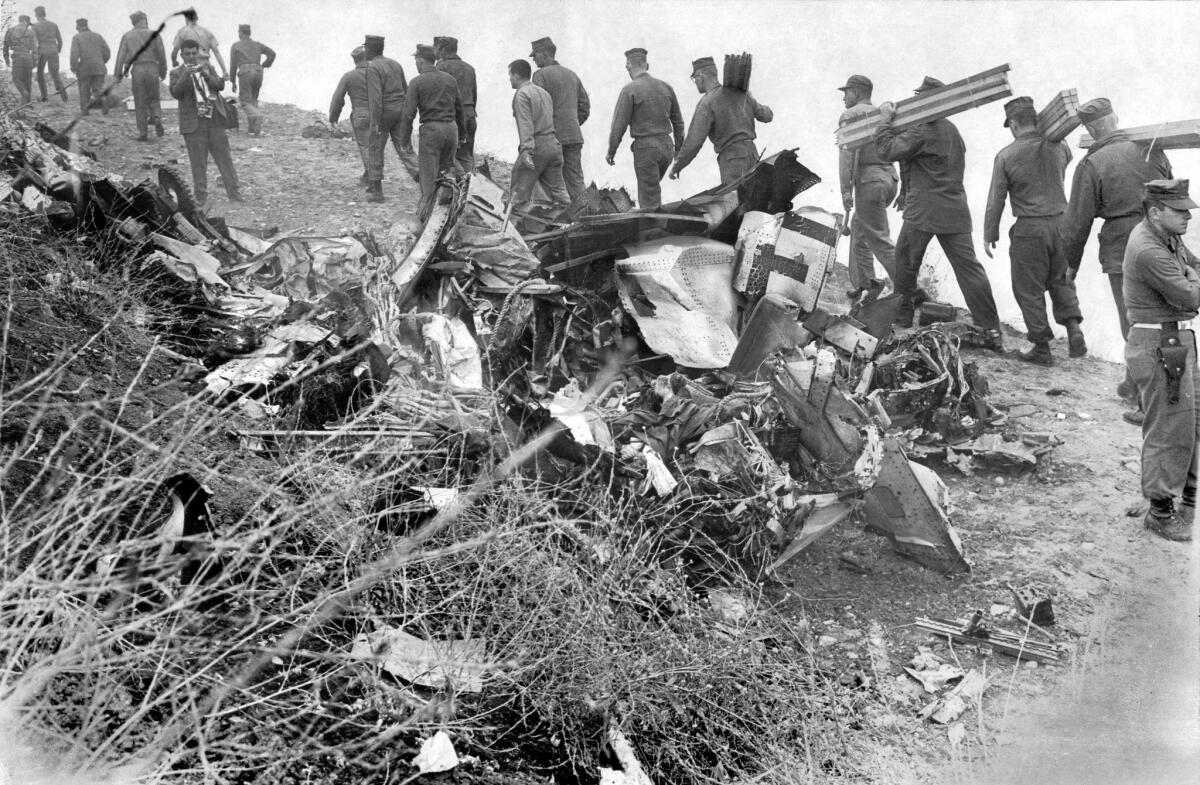California Retrospective: Orange County’s deadliest air disaster occurred 50 years ago this month

- Share via
The deadliest air disaster in Orange County history occurred 50 years ago this month.
In the early morning of June 25, 1965, an Air Force C-135 Stratolifter with 72 Marines and 12 crew members took off from El Toro Marine Corps Air Station and crashed into a nearby mountain.
Here’s a retrospective from The Times’ reporting:
Death was instantaneous for all aboard as the huge jet disintegrated in flames on a grass-covered hillside a mile wide.
A Marine spokesman said the aircraft should have climbed more rapidly after taking off from the 380-foot-elevation runway and also banked to the left toward the ocean.
Officials said the airport tower lost contact with the plane immediately after giving clearance for takeoff at 1:45 a.m. and then lost radar contact.
On the plane were 70 enlisted men from the 2nd Replacement Company, Staging Battalion, Camp Pendleton, who were being transferred to the 3rd Marine Division at Okinawa. Under normal replacement procedures, the 70 had been recruited from all over the country.
Some members of the 3rd Marine Division were fighting in Vietnam.
Two other Marines were “hitchhiking” a ride, Camp Pendleton reported.
It took more than four hours to find the crash site because fog and drizzle obscured the mountains.
At 6 a.m., Chief Warrant Officer John W. Andre, 46, and a four-man crew spotted the crashed plane from a helicopter on the fourth search flight of the early morning.
“At first I thought there were survivors shining flashlights at us,” Andre said. “Then we got closer and saw they were little grass fires.”
Andre maneuvered low enough to drop off a medical officer, Navy Lt. L. B. Frenger, and a crewman, Sgt. Bill Hastings.
“As soon as we looked,” Hastings said, “we could tell there was no one left.
“Even rabbits were dead.”
By late afternoon, all 84 bodies had been removed or located in hard-to-reach areas. The Orange County coroner’s staff had identified many through dog tags and fingerprints and were trying to identify others.
At Camp Pendleton, 20 miles to the south, 1,400 men from the replacement company were assigned to call their next of kin from a mobile telephone trailer to report that they weren’t aboard the ill-fated plane.
The crash was debated frequently during the long battle over whether to turn El Toro, which was closed by the Pentagon in the 1990s, into a civilian airport.
Airport foes argued that the crash showed it was unsafe for commercial jets.
In 2000, airport critics aired a cable television spot with footage of the crash.
Some former El Toro commanders slammed the ad, noting the crash was caused by pilot error and not, as the ad suggests, by an unsafe northern runway. They accused the anti-airport forces of “capitalizing on pain and human suffering just to make a political point.”
The spot shows body bags being hauled into a helicopter after what remains the county’s worst aviation disaster.
The ad’s creators argued it was a public service because it showed the danger of turning El Toro into an airport, a plan that was eventually scrapped.
On Saturday, officials gathered to remember those who died in 1965.
Eagle Scout Jordan Fourcher, 15, created an interactive memorial kiosk at a park at the old base. It features a metal base engraved with the names of the victims and an interactive touch screen with biographical information about the men.
Times staff writers Angel Jennings and Shelby Grad contributed to this report.